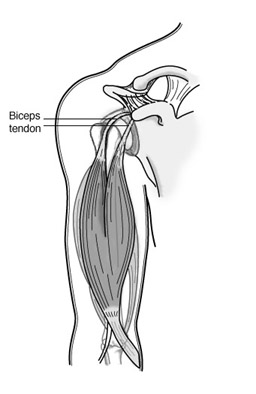Biceps Tendinitis
The biceps muscle, in the front of the upper arm, helps stabilize the upper arm bone (humerus) in the shoulder socket. It also helps accelerate and decelerate the arm during overhead movement in activities like tennis or pitching. Strong, cord-like structures called tendons connect one end of the biceps muscle to the shoulder in two places. At the other end of the muscle, tendons connect the biceps muscle to the smaller bone (radius) in the lower arm. If the tendons become inflamed or irritated, the condition is called tendinitis.
Signs and symptoms
Injuries to the biceps tendons are commonly caused by repetitive overhead activity. Symptoms include:
- Pain when the arm is overhead or bent.
- Localized tenderness as the tendon passes over the groove in the upper arm bone.
- Occasionally, a snapping sound or sensation in the shoulder area.
Diagnosis and treatment
During the physical examination, the doctor will assess the shoulder area for range of motion, tenderness and signs of shoulder instability. He or she may ask you to raise or rotate the arm. X-rays may be requested to uncover associated conditions that might cause irritation. The doctor may also request an MRI that can show any damage to the tendons. Overuse, aging and stress can cause the tendon to deteriorate, even if there is no inflammation present.
Initial treatment is conservative. The first step is to rest the arm and shoulder. Switch to another sport or activity for awhile. Ice applications and nonsteroidal anti-inflammatory medications such as ibuprofen can help reduce inflammation. Your physician can also recommend stretching and progressive strengthening exercises to build muscle endurance and restore range of motion. Then you can gradually return to overhead activity.
Surgical options
If the pain results from shoulder instability or from pressure on the tendon from the shoulder bones, your orthopaedist may recommend arthroscopic surgery. Using fiber optic technology and miniature instruments inserted through a small incision, the surgeon can examine the shoulder joint and anchor the tendon properly.
After surgery, your orthopaedist will prescribe a rehabilitation program that includes stretching and strengthening exercises. Early movement is important, but you should wait for your physician's approval before doing any heavy lifting or returning to sports.

September 2000
All Information Copyright © American Academy of Orthopaedic Surgeons
www.aaos.org